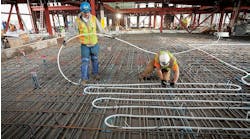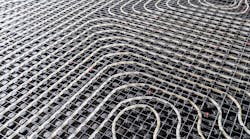Latest from Management
Sponsored
I talk to people on a daily basis about radiant heating and radiant cooling systems. Many people have a fairly good grasp on the basics of radiant. Some even think that if you load up a joist bay with as much tubing as you can stuff in there that it will work. Maybe yes, maybe no. Having been in the consulting business prior to taking my position with the Radiant Professionals Alliance (RPA), I saw many jobs where the physical plant and the distribution systems didn’t have parity. Think of it as driving a tack with a sledge hammer, or driving a railroad spike with a tack hammer. In either case, there will be problems.
I’d like to go over some of these problems in this column, and at the end, I want to introduce you to the ability to expand your horizons, increase your knowledge and become a recognized expert in your field.
Heat loss calculation? What’s a heat loss calculation? It is a well-known fact that radiant floors have a limitation of 30 BTUs per square foot per hour output capacity. So it reasons, that if that is the limit, then the easy thing to do would be to take the square footage of the building we are putting the tubing into and multiply it times 30, which tells us how big the boiler needs to be… Nothing could be further from the truth. By code (where properly applied and enforced) you are required to provide an accepted method of proving the heating and cooling needs of a given structure. Using rules of thumb will end up with significantly oversized systems that are terribly inefficient. Driving tacks with sledge hammers…
What is interesting here is that although many people know of the 30 Btu per square foot limitation, few people know why floors are limited to that special number. It isn’t a physical limitation, it’s a human physiology limitation. If your skin is in contact with a surface greater than 85°F (the temperature of a floor at a room temperature of 70°F) your body will assume it is going to overheat, and it goes into cooling mode, which means the people will be sweating. Sweating is not in my glossary definition of comfort. Now you know…
Plumbing and hydronics do have some very close relationships in that they both utilize pipes to transport water, but the similarities stop right there.
I can solder and I am licensed plumber, therefore I can do hydronics. Plumbing and hydronics do have some very close relationships in that they both utilize pipes to transport water, but the similarities stop right there. Knowing how to solder does not automatically give you the proper knowledge needed to properly design, install, maintain and troubleshoot a radiant hydronic system. In the plumbing trade, you typically have 70 PSI of driving force to move water through the piping system, whereas with hydronics, we have in some cases 1/10th that pressure to move fluid through a given circuit.
In plumbing, although code requires the pipes to be “reamed to full bore with all shavings removed,” it is a rare day that the plumber will take the time to ream their pipes prior to assembly. “So what’s the big deal? None of our plumbing customers complain about pressure drops or fluctuations in their plumbing systems…” It is a very delicate balancing act, that if attention is not paid to critical details, like full reamed pipes, and the location of the circulator or pump in relationship to the expansion tank connection, the system will not work as designed. Will it put out heat? Sure, but heat is just one component of comfort.
My longtime associate John Siegenthaler provided me with a very interesting quote recently. We were talking about how our industry has lost sight of true “hydronics.” No one seems to take the time necessary to read and follow the instructions that most manufacturers of critical system components provide with their equipment.
John said an old professor of his used to say, “You can’t do calculus without knowing algebra.” Ouch. He speaks the truth, and as a former expert witness, I can attest to this statement. There are some extremely important things that must be taken into consideration in order for the high efficiency comfort machines to be able to do their best, and if just one link in that critical chain is out of place, or improperly applied, the whole chain will suffer from poor efficiency. One thing I have learned in my life as a hydronics technician is that even on systems where it appears that nothing was done right, or properly or correctly, the system still put out heat. The end users will rally around the warmth. Remember, heat is but one component of comfort. If you are going to go to the time and trouble to call yourself a hydronics technician performing the art of radiant, it would probably be a good idea to get up to par on the science of hydronics that drives it.
We only do staple up. It’s the cheapest way to go. I think every contractor in America who has done radiant floors has had this feeling early in their career. I know I did. Then I realized that I was dealing with one of the most efficient methods of delivering overall comfort, and I decided that “cheap” wasn’t a word commonly associated with this industry.
Comfort and efficiency trump cheap and easy any day of the week.
I began looking at ways to make these systems more efficient, while maintaining the excellent level of comfort commonly associated with the installation. I also listened to John Siegenthaler about “Future proofing” my methodology of installation to make certain that the water temperatures I had to use were as low as possible.
Low water temperatures are a good thing when properly applied. I discovered extruded aluminum heat transmission plates that allowed me to perform the jobs with significantly less energy consumption, and that is a good thing right? Comfort and efficiency trump cheap and easy any day of the week. I never wanted to be the “cheapest” bidder. I always strove to be the most comprehensive, all inclusive bidder, that provided the end user with significantly more value than my competitors.
If you’d like to learn more about the science behind hydronics, please consider joining the RPA at www.radiantpros.org/join.You will not regret it and you will be much better off in your efforts to become recognized as a true expert in the field of hydronics and radiant heating and cooling.
Mark Eatherton material on this website is protected by Copyright 2016. Any reuse of this material (print or electronic) must first have the expressed written permission of Mark Eatherton and CONTRACTOR Magazine. Please contact via email at: [email protected].
Mark Eatherton
Mark Eatherton material on this website is protected by Copyright 2017. Any reuse of this material (print or electronic) must first have the expressed written permission of Mark Eatherton and CONTRACTOR Magazine.


